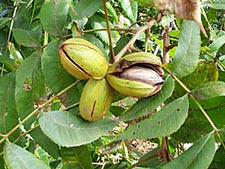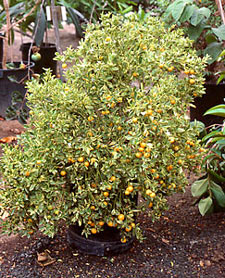
Persimmon trees produce gorgeous orange fruits that hang on the tree into fall and compliment the colorful fall foliage.

Nut trees such as pecans are long-term investments. They eventually become beautiful shade trees and the fruits provide food for wildlife and people.

Citrus trees come in many shapes and forms. Some are dwarf enough to grow in containers, making them easy to move indoors during winter in cold regions.

There is nothing like eating a tree-ripened peach. Pick when the background skin color turns from green to cream or yellow.
Trees are major features in a landscape. They can be used to provide shade, to soften a sharp corner or hide an unsightly view, or as an accent in a perennial flower garden. In an edible landscape they become more than just structures, they become food sources.
When selecting trees for your landscape, consider ones that will produce edible fruits and nuts. Fruit and nut trees are great because you don't need many of them (sometimes just one) to get an abundance of food. Some fruit and nut trees, such as persimmons, walnuts, pecans, and apples, can be grown for shade as well as fruit. Dwarf versions of these and other popular fruit and nut trees will even produce fruit when grown in a container.
Which Tree to Buy?When selecting fruit or nut trees, consider ones that are adapted to your climate. Also, pick the right tree for the right location. Nut trees, such as walnuts and pecans, grow to 50 feet or more at maturity, while some crab apples may only reach 10 feet tall.
Some types of fruit trees require at least two trees of different varieties in order to produce fruit. If you don't have room for two or more trees, consider self-fruiting varieties such as 'Northstar' cherry.
Also, don't limit your selection to the common fruits and nuts. There are many underutilized native and wild trees that make great edible landscape plants. Shadbush, dogwood, and pawpaw are native trees that are productive and easy to grow.
Finally, consider if the tree you're growing typically drops lots of fruits and nuts, creating a mess under the tree. Place these trees away from decks, patios, and sitting areas so you won't have any dropped fruits staining the wood or getting underfoot and attracting wasps and animals.
Planting TreesChoose a site in full sun with well-drained soil. Dig a hole two to three times as wide as the rootball (or about 2 to 3 feet wide for bare-root trees). Plant at the same depth the tree was growing in the container. For bare-root trees, set the tree atop a small mound of soil in the center of the planting hole, and spread the roots down and away without unduly bending them. Identify the original planting depth by finding color change from dark to light as you move down the trunk toward the roots. If the tree is grafted, position the inside of the curve of the graft union away from the afternoon sun and a few inches above the soil line.
For container trees, lift the plant out of the container prior to setting the rootball in the hole. Eliminate circling roots by laying the rootball on its side and cutting through the roots with shears. Don't cover the top of the rootball with backfill because it could prevent air and water from reaching the roots.
Fruit and Nut Tree ListFruit and nut trees are usually available in various sizes, so look for the size that will work well in your space. For instance, dwarf apple trees grow 8 to 12 feet tall; semi-dwarf, 12 to 18 feet; and standard, 18 to 30 feet. Some dwarfs adapt very well to containers.
 Charlie Nardozzi is an award winning, nationally recognized garden writer, speaker, radio, and television personality. He has worked for more than 30 years bringing expert gardening information to home gardeners through radio, television, talks, tours, on-line, and the printed page. Charlie delights in making gardening information simple, easy, fun and accessible to everyone. He's the author of 6 books, has three radio shows in New England and a TV show. He leads Garden Tours around the world and consults with organizations and companies about gardening programs. See more about him at Gardening With Charlie.
Charlie Nardozzi is an award winning, nationally recognized garden writer, speaker, radio, and television personality. He has worked for more than 30 years bringing expert gardening information to home gardeners through radio, television, talks, tours, on-line, and the printed page. Charlie delights in making gardening information simple, easy, fun and accessible to everyone. He's the author of 6 books, has three radio shows in New England and a TV show. He leads Garden Tours around the world and consults with organizations and companies about gardening programs. See more about him at Gardening With Charlie.
 Victory Seed Company has all the seeds you want for your best garden in 2024.
Victory Seed Company has all the seeds you want for your best garden in 2024.
For 25 years, the family-owned Victory Seed Company has provided the highest quality vegetable, herb and flower seeds to families across the country. We are passionate about providing you the best seeds available that give excellent germination, robust plants, and the harvest you want. With a catalog of over a thousand varieties, we have everything, and our prices are the kinds that we'd want to pay. We have hundreds of yesterday's heirloom vegetables, as well as today's award winning hybrid selections. Get to know us by visiting our website and browsing through our online vegetable seed catalog.